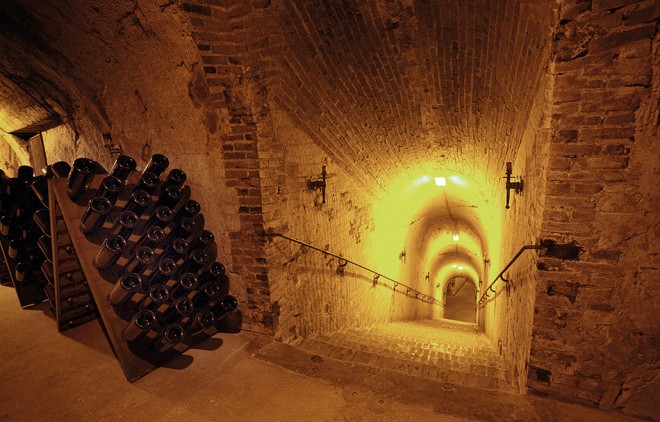
The famous “oldest Champagne wine making house” recently experienced a major change. In 2009 it left its native village of Ay to relocate in Epernay. It settled in an impressive 19th-century mansion, surrounded by a two-hectare wooded park. A location that is large enough to fit its needs and match its ambitions.
Two blocks from the famed ‘Avenue de Champa-gne’, Gosset built a semi-buried cellar that houses over sixty tanks ranging from forty to two hundred hectolitres in size. A variety of sizes justified by the fact that its musts are vinified village by village, and sometimes plot by plot. The intent being to respect the typicity of each terroir–since its grapes are grown in over thirty different ‘crus’, with a majority of them ranked as first (Premier Cru) or great (Grand Cru)–as well as the specific know-how of the more than one hundred grape growers that the house works in close relationship with. “The truth is in the tastings”, Odilon de Varine, general director of Gosset, as well as its current cellar master, says. “Our selection process involves blind tasting all of our still wines and there are over one hundred and sixty of them”. Indeed, Gosset just released a Blanc de Blancs Champagne, made from the 2010 and 2011 vintages, with grapes coming from some famed ‘grand crus terroirs’ such as Avize and Mesnil-sur-Oger, as well as lesser known Premier Crus, such as Villers-Marmery or Trepail.
There are about as many maturation tanks for still wines as there are vinification ones. But it is the gigantic size of the blending tanks that reminds us that Gosset sells over one million bottles every year in 80 different countries.

Such a large volume however has not altered the family structure and family approach that have been characterizing Gosset for over 400 years. The Gosset family made wine before it made Champagne. It still considers itself a ‘maker of wine’. “We blend terroirs”, says Odilon de Varine. “We make wine, not bubbly. In a Champagne, the bubbles must serve the wine, not the reverse; bubbles are there as a support to the wine’s ageing capacity.” The Gosset style is also about putting forward the specific minerality of the chalky soil. “Chalk can be seen as the tannins of a white wine”, says Bertrand Verduzier, export director for Gosset.
Vinifications take place in stainless steel tanks, on the lees, and malolactic fermentation is systematically avoided. It is a trademark. “The malolactic fermentation tends to level down the wine”, Odilon de Varine says. “Malic acid comes from the fruit, if you eliminate it, you eliminate the terroir component of the wine.”
Gosset’s other trademark is the importance given to time in the elaboration of their Champagne cuvees. The Grande Réserve Brut, the house’s non-vintage brut made from all three varietals, spends a minimum of three years ageing on the lees. The Grand Millésime 2006 spent eight such years. This very spring 2016, Gosset released a special cuvee named “15 ans de cave a minima” (‘fifteen years in the cellar, no less’). It is a blend of Chardonnay (60%) and Pinot Noir (40%) with a dosage of 7gr/l that has actually spent sixteen years ageing. It was bottled and laid down in the cellar back in 1999. In some way it is the last vintage champagne of the 20th century.
This particular cuvee expresses Gosset’s pursuit of excellence, with wines that have both perfect roundness and freshness. It also illustrates the house’s desire to break the codes. To work on ageing, not just on vintages. That is why chronology is no guide when it comes to releasing their vintage cuvees. They do not all age similarly. Some become ready faster than others. Odilon de Varine confesses to be actually dreaming of a special range of Champagne cuvees based on the disgorgement dates and the amount of post dosage maturation time. “Champagne makers are actually the true specialists of wine ageing”, he says with a hint of provocation in his tone. “The barrier between non-vintage and vintage cuvees can be brought down.”
Gérald Olivier